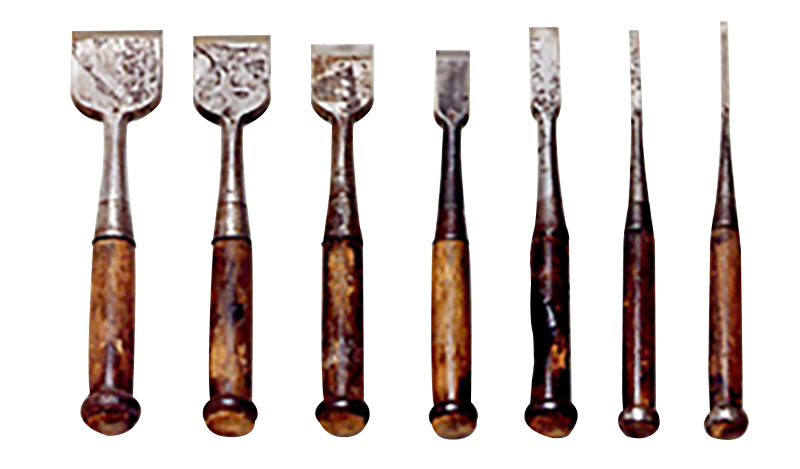10 Chiyozuru and Edo bear
Chiyo Tsuru Korehide (real name, Hiroshi Kato) was born in Iikura, Tokyo in 1874 as the third son of the second swordsmith, Nagaun Naotoshi.
At the age of eleven, he was the eighth generation of the Ishido family, who had been famous as a swordsmith in Azabu, Tokyo for generations, and was entrusted to the Ishido family as a disciple of his uncle, Koreichi (Juei era), and he walked the road of tool blacksmith. He was the same year as Koreichi's eldest son, Shuichi 9th, and he was also a good training friend.
At the age of 21, he married Koreichi's daughter Nobu. He lived in the Ishido family until 1899, when he was 26 years old, but at that time he became independent and called himself 'Chiyozuru.' Since then, he has left many anecdotes along with his fame until his death at the age of 84 in 1957. His forged knives have been called the highest peak of this road since the Meiji era, along with their sharpness, their style and beauty of modeling, and they have sublimated their life from "use to beauty" for those who seek and use it.
On the other hand, the kitchen was always a fire car because of the windy spirit that did not work for food, and it seems that the kitchen was always a fire car.
This is also given to close and caring people by hitting hatches, nails, cutting swords, kitchen knives, razors, scissors, and fire chopsticks between work, but even today, these are the envy of lovers.
I met Edo bear in 1919 when I was 40 years old. The story of his encounter with Edo bears is described in detail in Hideo Shirasaki's book "Chiyozuru Kohide". According to this, around 1919, there was a carpenter named Jiro Kato, who was in Osaka. He was born in Awa Chiba, and since he was a child, he became a disciple of the master of Tokyo, and although his arm was certain, he did not fit with his master because of his temperament, he flowed to Kansai and worked as a Furai craftsman in Osaka, but it is said that 'Edokuma' became a street name from the fact that he sprinkled with Edokko dialect.
The tools of Chiyozuru, who gave his name at a young age, were so many craftsmen who sought to celebrate in household miniature shrine rather than to use them, but the Edo bear, who knew Chiyozuru's chisel, had a letter written with a wish to Chiyozuru, who had no knowledge, and sent a copy of his family register.
The master should know the master, and Chiyozuru, based on his heart, trained 15 inlet chisels to order, and made the train fare to Osaka by night. Chiyozuru always handed it directly to the orderer to confirm the evaluation.
It is also interesting that the two people who met each other for the first time at Osaka Station show each other's poverty. Chiyozuru was a lifelong oligarch and expensive, but it was not easy to live, because he always worked hard until he was convinced. Nevertheless, how did you deal with the price of the poor carpenter Edo bear?
According to Hideo Shirasaki, the time and effort of carpenters around the Taisho era was usually 1.50 yen, 3.50 yen for each set of 10 carpenter chisels, 7.50 yen for superior goods, and shuichi Ishido was exceptionally 75 yen. However, Chiyozuru was 100 yen per set. The order for Edo bears was 15 pieces, so it is at least 150 yen. He asked for a huge debt for his arm.
The story goes on around 1940. In Kibiki-cho, Tokyo, there is the Kato family that has been running a ryokan since the middle of the Meiji era. Mr. Toshio Kato was the second head of the house. According to his daughter's story, he was a hobbyist and very elaborate person, and suddenly met Chiyozuru's teacher, went to the Chiyozuru family in Meguro, where he was busy, and he was good at hitting a knife himself. On the other hand, he seems to have taken care of the Chiyozuru family from the back.
Around that time, the daughter of Edokuma came to Tokyo from Osaka, relying on Chiyozuru. After the Edo bear died, he came to consult about the end of the chisel. At that time, Chiyozuru's chisel numbered 37 pieces. In the end, Mr. Takahashi took over this. This year, Mr. Takahashi died, and I visited Iwamoto (former Director of Takenaka Carpentry Tools Museum) with the introduction of tool researcher Ichiro Tsuchida tothe museum.
During the war, Mr. Tsuchida took care of the chisel that had been evacuated to a villa in Kamakura. The chisel of the Edo bear, who followed the fate of a strange thing, finally gained a place of rest.
